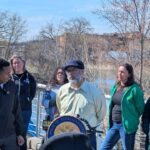One of the more unusual, and today nearly forgotten, Bronx River communities is the old “Mile Square.”
The Mile Square was exactly that – a one square mile tract of land whose east side was the Bronx River, and whose southern boundary stretched west from the river from a point just a few blocks north of Muskrat Cove.
Carved out in 1670 from the patroonship of Adrian Van der Donck (the “Jonk Heer” or “Young Lord” from whom we get the name of “Yonkers”,) the Mile Square became truly a place apart in 1693 when it was exempted from the royal charter that created the manor of Philipsburg. Unlike the tenants of the vast manor that surrounded it on three sides, the small farmers of the Mile Square owned their own land outright. This encouraged an independent outlook that made the Mile Square an especially pro-American community during the Revolution, in contrast to their neighbors whose Loyalist landlord Frederick Philipse compelled them to support the King – or else.
This rebel patch of Westchester was conveniently located for the American forces, as the (original) Mile Square Road was the chief North-South route connecting Kingsbridge with lower Westchester County, and on the east side was Hunts Bridge (at the present-day end of Sherwood Avenue,) which was the first bridge crossing the Bronx River north of Williamsbridge.
American forces occupied the Mile Square on a number of occasions during the war, notably before the battle of White Plains in October, 1776, and again before the battle of Kingsbridge in August 1778. For the Americans the Mile Square was not only a friendly rest stop, but a strategically situated launching point for raids and reconnaissance patrols into the contested area of “the Neutral Ground,” today known as the Bronx.
The Mile Square lost its social and political distinction after the end of the war when the manor of Philipsburg was confiscated from the Tory Philipse family and sold off to individual farmers. It is recalled today by the curiously-named Mile Square Road that still wends its way through southern Yonkers.
Stephen Paul DeVillo





